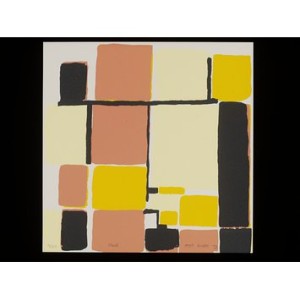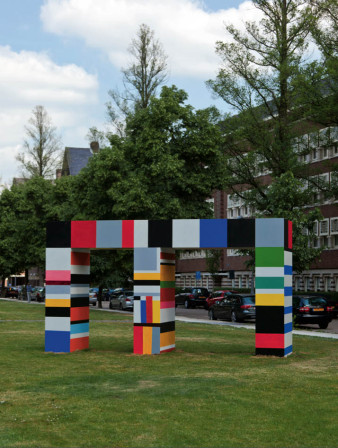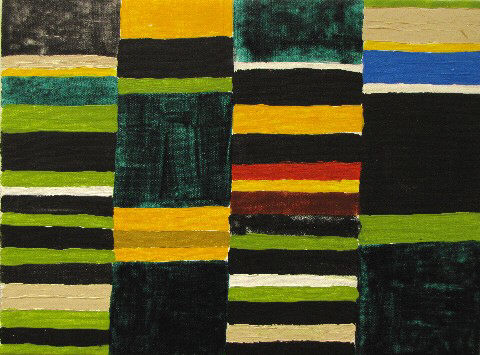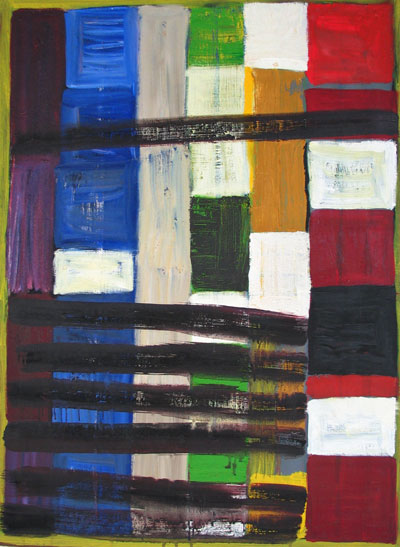
This work ‘Mask’ of Atta Kwami (1956) is part of the collection of V & A Museum in London.
About:
Atta Kwami’s works play with the colour and form improvisations that are distinctive of Ghanaian architecture and African strip-woven textiles, especially those (kente) made famous by his culture, the Ewe and Asante of Ghana.
The work explores the dynamism, rhythmic structures and the power of improvisation in African visual practice as he has experienced it. It evokes the resilience and personal struggles to rise to a level of hope and order in which excellence may be attained. By ‘good work’, he means the energy is rightly placed in terms of wholeness and process. He values the kind of work in which the interaction between innovation and tradition is a subtle matter. These are likened to conversations with art from Africa and beyond.
 Susuka, 2010.
Susuka, 2010.
When he paints, he is sometimes in a trance; other times it feels like a conversation between himself and the materials; or with other artists, alive and dead, African and non-African. The artist in the studio is alone. The usual ruses to make conversation with others are not possible but dialogue with materials sets in motion a vehicle for argument and counter-argument. To him the act of painting may be likened to walking a tightrope, much like performing an operation to save a life. Besides invoking the tempered palette of Ewe kente cloth, it hints at the frailty of human life especially in Africa. A common compositional scheme for his art forms appears to be the repetition of a single motif within a horizontal or sometimes vertical register. These features appertaining to the work may be found in art forms from northern and southern Ghana: the wall paintings, pottery and textiles and the work from the sign painting workshops in urban centres that he has studied.
 Sculpture on ArtZuid Amsterdam, 2013.
Sculpture on ArtZuid Amsterdam, 2013.
The painting becomes an object. Yellow ochre, raw sienna, red ochre, indigo, mars black, brilliant yellow: genuine yellow light; permanent yellow light and greys convey different shades of light and line. Colour has magic but it’s not the colour alone: the two dimensional space of the canvas is marked with shapes of numerous square and rectangular coloured sections of different sizes. When he looks at the work again objectively it seems to be larger than its parts; he has pursued the use of an imaginary grid as a matrix for emotion. This structure is a smokescreen within which to create something new.
 Bankoe, 2010.
Bankoe, 2010.
‘The qualities I seek in my work are: clarity, simplicity, intensity, subtlety, architectonic structure, musicality (rhythm and tone), wholeness and spontaneity. So many strands inevitably manifest themselves in painting: jazz, the timbre of Ghanaian music (Koo Nimo), improvisation, arrangements of merchandise and so forth. I also see corresponding aesthetic commonalities with wall paintings and music from northern Ghana, the limited range of earth colors and the pentatonic scale of the xylophone. Poetry is able to sustain the life of language through new forms of usage. In painting it is also re-interpretation, improvisation and variation that affect innovation and development.’
Atta Kwami
Cambridge 2012
 Atideka, 2011.
Atideka, 2011.
Courtesy: Howard Scott
529 West 20th Street 7th Floor
New York, New York
 Karnak, 2001.
Karnak, 2001.
